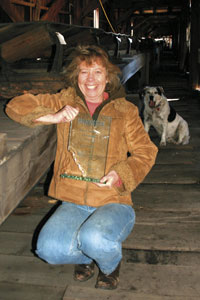 Atlas Coal Mine manager Carla Powell jokes, comparing the Atlas Coal Mine National Historic Site to the Little Engine That Could… but they did, and won the Rural Champion Award at the Growing Rural Tourism Conference in Camrose.
Atlas Coal Mine manager Carla Powell jokes, comparing the Atlas Coal Mine National Historic Site to the Little Engine That Could… but they did, and won the Rural Champion Award at the Growing Rural Tourism Conference in Camrose. The award was presented on April 7, during a three day summit on rural tourism at the Camrose regional exhibition.“It’s the little Mancha locomotive (the electric mine train the Atlas restored and now offer rides on) that could,” laughs Powell who accepted the award presented by Minister of Tourism the Honourable Cindy Ady. “It is such a huge honour and it is wonderful to receive recognition when you work so hard.”The Atlas beat out finalists that included larger scale operations including Blackfoot Crossing Historical Park, the Medicine Hat Clay Industries National Historic District, Reel Adventures-Alberta Movie Maps, the Lac La Biche Winter Festival of Speed and Canadian Badlands.“I was looking at the list of nominees, and I was like, ‘we’re with the big boys now.’ The list of nominees are amazing people and organizations,” said Powell. “What made us different when they were adjudicating the nominees that we are a small organization and operators, and we took on a behemoth of a project. The scale of what we did, compared to the capacity that we have, was out of this world. Despite this we still took the risk, and we did it!”The endeavor which Powell is referring to is the first stage of Tunnel Vision. In December of 2007, a crew of miners began the task of opening up the 210 foot- conveyor tunnel from the surface plant, (tipple) to the mine entrance. The crew was on site for nine months, and timber by timber, (174 in all) shored up the historic tunnel battling against unstable ground, and cave-ins. The small crew, armed with the very basic of mining tools, hauled out 260 tons of material. Through budget overruns and changing weather, the project prevailed.“It’s a good news story at the end of the day, it came at the expense of blood, sweat and tears, literally and figuratively,” said Powell.The project, originally expected to take three months, saw the timeline triple, and costs soar to about $800,000 more than expected, but they prevailed, and this season they will be able to offer visitors the underground experience.For Linda Digby, executive director at the Atlas, who has guided this project since the beginning, this was affirmation.“What we did was so hard, and frankly if we had known how hard it was, we never would have gone down that road,” she said. “For a little organization like us to take on such a massive undertaking, it’s never a clean path from A to B, it felt like finding your path through the dark woods.”“You always wonder if you are doing the right thing, if you are doing it right and if you are in over your head. You question, ‘should I be doing this if it is so hard?’ We were convinced deep down inside this was the right project for all the right reasons. It was all about preserving the miners’ legacy, it was about preserving a nationally designated structure and it’s all about the amazing learning opportunities we are able to provide people. It will create memories, plus it will be such a cool addition to the local experience for visitors.”Digby expresses pride in the project.“We’re a small organization, there are just a couple of us out here, and we are way down the valley,” she said. “You kind of wonder if anyone sees what you are doing, but it is worth doing, even if nobody notices. “But man, when somebody notices what an accomplishment it was, it feels really good.”